Use only the data that were available at the time of prediction
GARCH Models in R

Kris Boudt
Professor of finance and econometrics
Volatility prediction by applying `sigma()` to `ugarchforecast` object
garchspec <- ugarchspec(mean.model = list(armaOrder = c(0,0)), variance.model = list(model = "sGARCH"), distribution.model = "norm") garchfit <- ugarchfit(data = sp500ret, spec = garchspec) garchforecast <- ugarchforecast(fitORspec = garchfit, n.ahead = 3) sigma(garchforecast)2017-12-29 T+1 0.005034754 T+2 0.005127582 T+3 0.005217770
Volatility estimation by applying `sigma()` to `ugarchfit` object (i)
head(sigma(garchfit), 3)
1989-01-04 0.01099465
1989-01-05 0.01129167
1989-01-06 0.01084294
tail(sigma(garchfit), 3)
2017-12-27 0.005051926
2017-12-28 0.004947569
2017-12-29 0.004862908
Volatility estimation by applying sigma() to ugarchfit object (ii)
Look ahead bias: Future returns are used to make the volatility estimate.
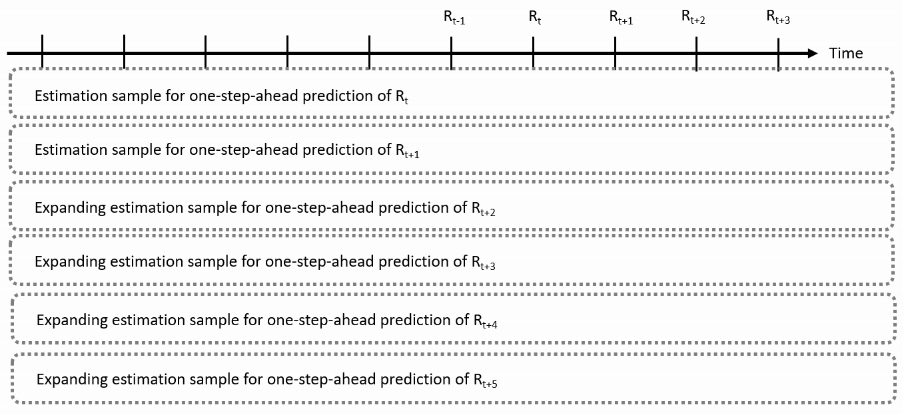
Solution to avoid look-ahead bias: Rolling estimation
- Program a
forloop: Iterate over the prediction times and useugarchfit()to estimate the model andugarchforecast()to make the volatility forecast - Built-in function
ugarchroll()in therugarchpackage - Options:
- Length of the estimation sample
- Frequency of model estimation
Expanding window estimation
Use all available returns at the time of prediction
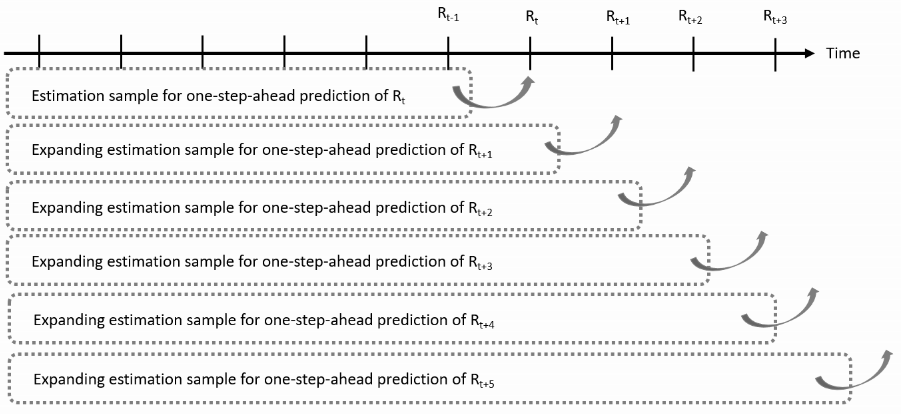
Moving window estimation
Only use a fixed number of the most return observations available at the time of prediction
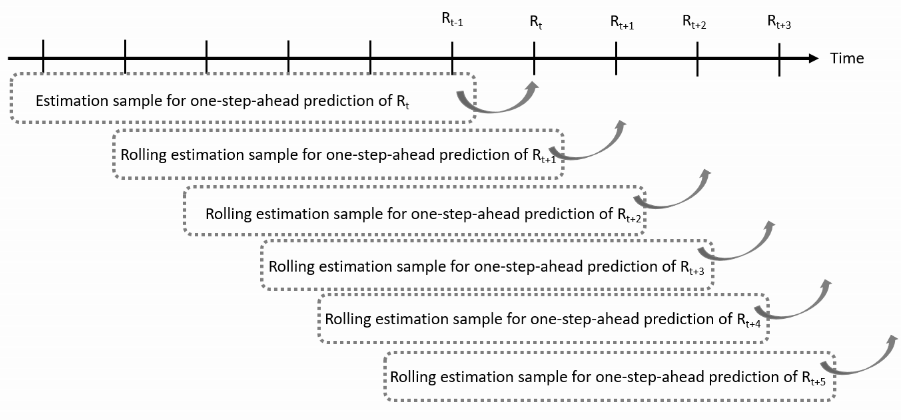
Properties of rolling window estimation
- Rolling window lets you adapt to changes in the model parameters
- Computational cost of
ugarchroll()is the loop across prediction times:- Can be reduced by re-estimate the model at a lower frequency than the frequency of prediction
Rolling and re-estimation
Reduce the computational cost by estimating the model every $K$ observations
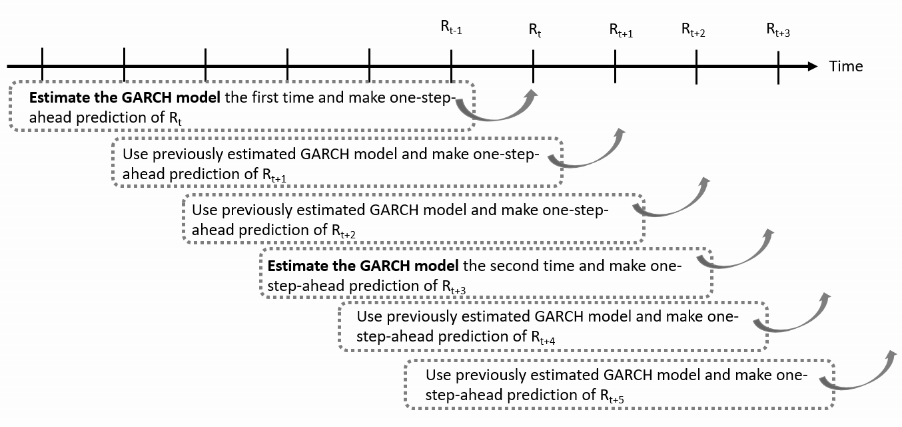
Function ugarchroll
garchroll <- ugarchroll(tgarchspec, data = EURUSDret, n.start = 2500,
refit.window = "moving", refit.every = 500)
Arguments to specify:
- GARCH specification used
data: return data to usen.start: the size of the initial estimation samplerefit.window: how to change that sample through time: "moving" or "expandingrefit.every: how often to re-estimate the model
Example on the Jan 1999-Dec 2018 daily EUR/USD returns
For the 4961 EUR/USD returns with 4961 observations, starting on 1999-01-05 and using a moving estimation window of 2500 observations:

Output of changing parameters
Method coef() produces a list with the estimated coefficients for each estimation
coef(garchroll)[[1]]
$index
"2008-12-08"
$coef
Estimate Std. Error t value Pr(>|t|)
mu -1.480000e-04 1.330915e-04 -1.11201737 0.2661307
ar1 -2.953484e-03 1.985344e-02 -0.14876432 0.8817396
omega 7.498928e-08 5.587618e-06 0.01342062 0.9892922
alpha1 2.805079e-02 6.401139e-02 0.43821564 0.6612300
beta1 9.709400e-01 6.080197e-02 15.96889122 0.0000000
shape 1.098068e+01 2.609293e+01 0.42082981 0.6738794
Changes between estimation windows
coef(garchroll)[[1]]$coef # 2008-12-08
Estimate Std. Error t value Pr(>|t|)
omega 7.498928e-08 5.587618e-06 0.01342062 0.9892922
alpha1 2.805079e-02 6.401139e-02 0.43821564 0.6612300
beta1 9.709400e-01 6.080197e-02 15.96889122 0.0000000
coef(garchroll)[[5]]$coef # 2016-11-28
Estimate Std. Error t value Pr(>|t|)
omega 8.982527e-08 2.639680e-05 0.003402885 9.972849e-01
alpha1 4.149787e-02 2.550381e-01 0.162712424 8.707449e-01
beta1 9.573885e-01 2.195782e-01 4.360125676 1.299878e-05
What is the rolling predicted mean and volatility?
For the EUR/USD returns with n.start = 2500, the first prediction is for observation 2501, namely 2008-12-09:

Method as.data.frame()
preds <- as.data.frame(garchroll)
head(preds, 3)
Mu Sigma Skew Shape Shape(GIG) Realized
2008-12-09 -8.271288e-05 0.01196917 0 10.98068 0 0.0003864884
2008-12-10 -1.495786e-04 0.01179742 0 10.98068 0 -0.0066799754
2008-12-11 -1.287079e-04 0.01167929 0 10.98068 0 -0.0203099142
Note:
preds$Mu: series of predicted mean valuespreds$Sigma: series of predicted volatility values
Predicted volatilities
garchvol <- xts(preds$Sigma, order.by = as.Date(rownames(preds)))
plot(garchvol)
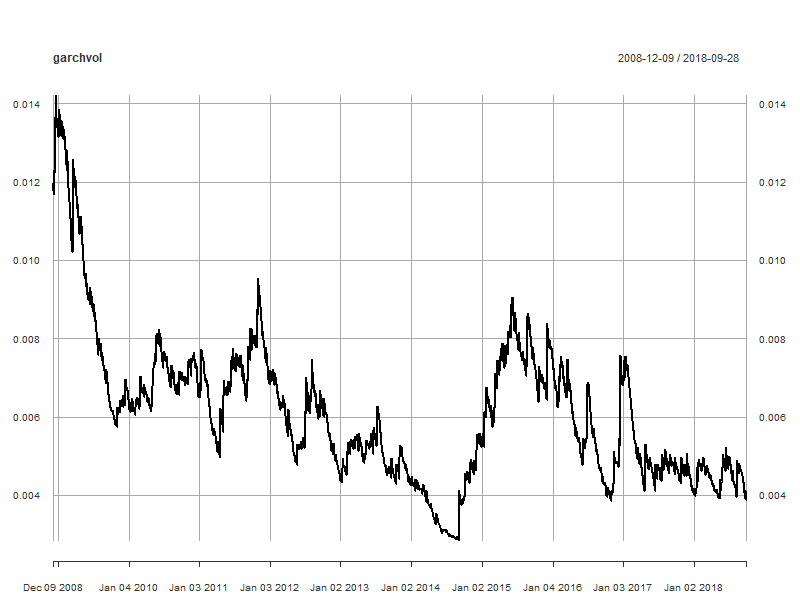
Accuracy of rolling predictions
preds <- as.data.frame(garchroll)
head(preds)
Mu Sigma Skew Shape Shape(GIG) Realized
2008-12-09 -8.271288e-05 0.01196917 0 10.98068 0 0.0003864884
2008-12-10 -1.495786e-04 0.01179742 0 10.98068 0 -0.0066799754
2008-12-11 -1.287079e-04 0.01167929 0 10.98068 0 -0.0203099142
2008-12-12 -8.845214e-05 0.01199756 0 10.98068 0 -0.0041201588
2008-12-15 -1.362683e-04 0.01184438 0 10.98068 0 -0.0230532787
2008-12-16 -8.034966e-05 0.01228900 0 10.98068 0 -0.0105720492
Evaluate accuracy of preds$Mu and preds$Sigma by comparing with preds$Realized
Mean squared prediction error for the mean
# Prediction error for the mean
e <- preds$Realized - preds$Mu
mean(e ^ 2)
3.867998e-05
Mean squared prediction error for the variance
# Prediction error for the mean
e <- preds$Realized - preds$Mu
# Prediction error for the variance
d <- e ^ 2 - preds$Sigma ^ 2
mean(d ^ 2)
6.974161e-09
Compare two models
Standard GARCH with student t distribution
tgarchspec <- ugarchspec(mean.model = list(armaOrder = c(1, 0)),
variance.model = list(model = "sGARCH"), distribution.model = "std")
garchroll <- ugarchroll(tgarchspec, data = EURUSDret, n.start = 2500,
refit.window = "moving", refit.every = 500)
GJR GARCH with skewed student t distribution
gjrgarchspec <- ugarchspec(mean.model = list(armaOrder = c(1, 0)),
variance.model = list(model = "gjrGARCH"), distribution.model = "sstd")
gjrgarchroll <- ugarchroll(gjrgarchspec, data = EURUSDret, n.start = 2500,
refit.window = "moving", refit.every = 500)
Comparison of prediction accuracny
Standard GARCH with student t distribution
preds <- as.data.frame(garchroll)
e <- preds$Realized - preds$Mu
d <- e ^ 2 - preds$Sigma ^ 2
mean(d ^ 2) # yields 6.974161e-09
GJR GARCH with skewed student t distribution
gjrpreds <- as.data.frame(gjrgarchroll)
e <- gjrpreds$Realized - gjrpreds$Mu
d <- e ^ 2 - gjrpreds$Sigma ^ 2
mean(d ^ 2) # yields 6.965095e-09
The proof of the pudding is in the eating
GARCH Models in R

